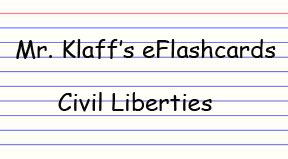|
|
|
 |
|
|
|
|
|
Question:
To what extent is free speech in the First Amendment limited?
Answer: Free speech has several limitations. Here are two
landmark cases that elaborate on free speech:
1.
Schenck v.
United States, 1919 -
Charles Schenck was a member of the Socialist Party. He
distributed thousands of leaflets containing damaging language
against the World War I draft. Consequently, he was arrested
for violating the Espionage Act, which made it illegal to
disrupt the war effort. Weren’t those leaflets protected by
the free speech clause of the First Amendment? The Supreme
Court said “no.” Free speech was not absolute, as Schenck was
creating a
“clear and present
danger.” According to Justice Oliver Wendell Holmes,
Jr., Schenck’s actions were like “shouting fire in a theater.”
2.
In the 1951 case of
Dennis v.
US, the Supreme Court ruled that speech advocating for
an overthrow of the government was not protected by the First
Amendment. Eugene Dennis of the American Communist Party had
violated the
Smith Act of
1940, which made such talk a crime.
Unlike the other two cases, the
Texas v.
Johnson (1989)
decision expanded free speech. The Supreme Court ruled that
burning of the American flag was protected by the First
Amendment. Click here for next flash card Back to eFlashcard headquarters
|
|
 |
 |
 |

|

